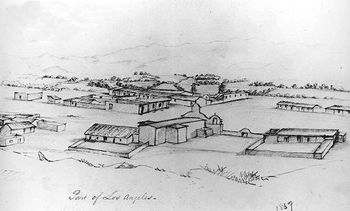Nuestra Señora Reina de los Angeles Asistencia
| This article is part of a series on the Spanish missions in California  Los Angeles Plaza circa 1847. The "Plaza Church" (foreground, seen from the rear) occupies what remains of the original Mission San Gabriel Arcángel asistencia site.|[1] | |
| HISTORY | |
|---|---|
| Location: | Los Angeles, California |
| Coordinates: | 34° 05′ 69″ N, 118° 23′ 90″ W |
| Name as Founded: | Asistencia de la Misión San Gabriel, Arcángel [2] |
| English Translation: | Attendant to the Mission San Gabriel Arcángel [2] |
| Patron Saint: | Mary, Mother of Christ [2] |
| Nickname(s): | "La Placita" |
| Founding Date: | 1784 [2] |
| Military District: | First [3][4] |
| Native Tribe(s): Spanish Name(s): |
Tongva Gabrieliño |
| Primordial Place Name(s): | Yaanga [5] |
| DISPOSITION | |
| Caretaker: | Roman Catholic Diocese of Los Angeles |
| Current Use: | Parish Church |
| California Historical Landmark: | #144 |
| Los Angeles Historic-Cultural Monument: | #3 [6] |
| Web Site: | http://www.laplacita.org/ |
The Nuestra Señora Reina de los Angeles Asistencia is a former religious outpost established by Spanish colonists on the west coast of North America in the present-day State of California (U.S. state). Originally founded in early 1784 within the burgeoning Pueblo de Los Angeles as an asistencia (or "sub-mission") to the nearby Mission San Gabriel Arcángel, the outpost fell into disuse over time and a Catholic chapel, La Iglesia de Nuestra Señora Reina de los Angeles, was constructed in its place three decades later. Designated as a California Historical Landmark, today it is most often referred to as the "Plaza Church."
History
Asistencia de la Misión San Gabriel, Arcángel
In the first months of 1784, priests from San Gabriel established an assistant mission in the neighboring Pueblo de Los Angeles along the banks of El Rio de Nuestra Señora La Reina de Los Angeles de Porciúncula, in an area with a high concentration of potential converts. At a half-a-day's ride to the east, the mother mission was too distant to serve the area effectively. Father Presidente Junípero Serra had the opportunity to visit the asistencia on March 18, 1784, just five months before his untimely death. Perhaps more important than its duty to provide religious instruction to the local natives was the settlement's role in growing crops and grazing livestock to feed the inhabitants of Mission San Gabriel, whose padres divided their time between that outpost and the new site.[7] The abundant water supply allowed for the planting of citrus orchards and raising of cattle in abundant numbers.
In time, however, the priests would be forced to abandon the site as the pueblo grew in population and the native poblanos moved away (few of the nuevos cristianos were welcomed in the Pueblo). Relatively little of the site's physical record survives today.
La Iglesia de Nuestra Señora Reina de los Angeles
On August 18, 1814 Fray Luis Gíl y Taboada placed the cornerstone of a new church amidst the ruins of the former asistencia to serve the local pobladores (settlers);[8] the completed structure was dedicated on December 8, 1822[2] and granted parochial status in 1826. The padres of San Gabriel donated 7 barrels of brandy to help establish the new chapel.[9] A replacement chapel, named for Mary, Mother of Christ (La Iglesia de Nuestra Señora de los Angeles, or "The Church of Our Lady of the Angels") was rebuilt utilizing materials of the original church in 1861; Reina, meaning "Queen," was added later.[10] For years the little chapel, often referred to as the "Plaza Church" (which has operated under the auspices of the Claretian Missionary Fathers since 1908) served as the sole Roman Catholic church in Los Angeles. The Plaza area today is popularly known as Olvera Street.
Architectural evolution
While the original 1822 adobe edifice was outfitted with a flat roof structure, in 1875 the façade was rebuilt and a gable roof added. 1875 saw the construction of a campanario ("bell tower"), and 1912 the chapel was renovated and enlarged to its current footprint. A clay tile roof replaced the wood shingles in 1923. Throughout the years various the façade underwent a number of changes that included removal of the bell tower in favor of a three-bell espadaña ("bell wall") which resulted in the look that has essentially been maintained to this day.[11]
Notes and references
- ↑ (PD) Drawing: Unknown
- ↑ Jump up to: 2.0 2.1 2.2 2.3 2.4 Ruscin, p. 49.
- ↑ Forbes, p. 202
- ↑ Engelhardt 1920, pp. v, 228: "The military district of San Diego embraced the Missions of San Diego, San Luis Rey, San Juan Capistrano, and San Gabriel..."
- ↑ Ruscin, p. 195.
- ↑ Los Angeles Department of City Planning (September 7, 2007). Historic - Cultural Monuments (HCM) Listing: City Declared Monuments (PDF). City of Los Angeles. Retrieved July 8, 2013.
- ↑ Harley.
- ↑ California Mission Studies Association.
- ↑ Krell, p. 125.
- ↑ Ruscin, p. 50.
- ↑ Gephard and Winter, p. 262